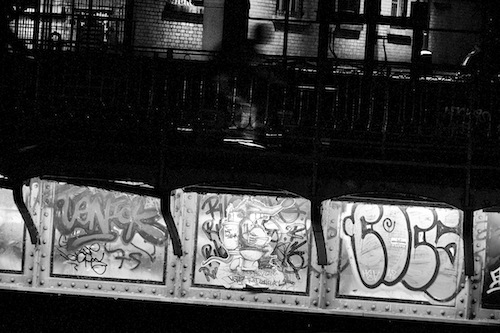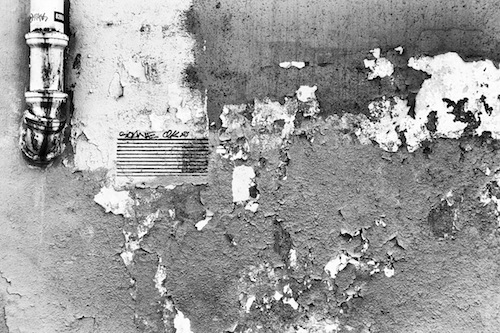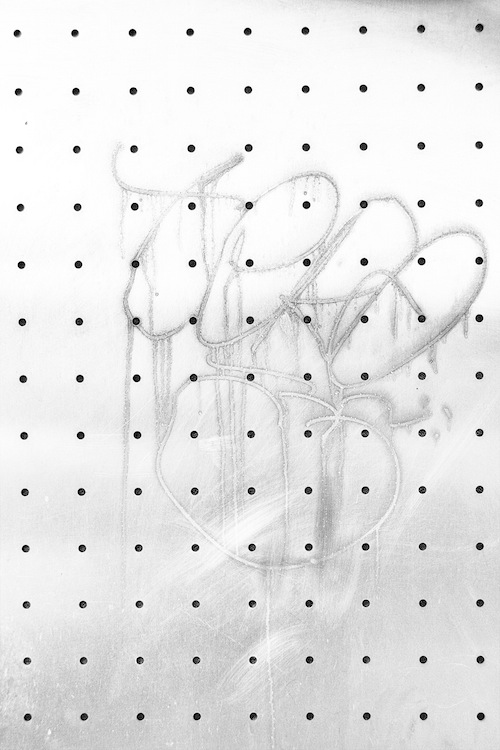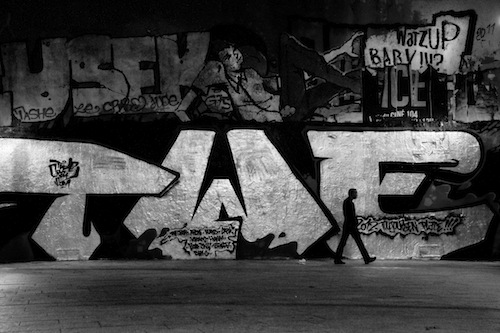Who: Andrew Zawacki
What: Paris graffiti
When: June, 2012
Where: Paris, France
“Open Door” features audio, video, and online media to document dynamic interactions between poetry and its audience. “Open Door” showcases performance, scholarship, and engagement outside the usual boundaries of slams, workshops, and book publications. This week: Photograffiti in Paris.
***

Graffiti is a city’s subtitle. Scrawled against the urban landscape, like captions printed on a film, graffiti scrolls along the lower surfaces of the urban panorama: walls, garbage trucks, letterboxes, a catwalk above the Canal St. Martin, macadam and scaffolding, phone cabin windows, underground networks, amphibious trains. And also like a subtitle, once you start following its contours and curlicues, its alphabets rife with numbers and runes, its vandal economies, graffiti becomes the only thing you see—peinture to the seventh power: graffiti-itis. Pull its cartoonish bubbles and aggressive zigzags into focus, the rest of the faubourg goes blurry. As if Paris were suddenly just subtext, or pretext—quiet on the set—and graffiti the full-length feature presentation. A “flickery jumping art of the slums and dumpsters,” as graffitist Ismael Muñoz would have it, in Don DeLillo’s Underworld, “flashing those colors in your face—like I’m your movie, motherfucker.”

But whereas subtitles translate a foreign language into one you can understand, graffiti—far from being “domestic” translation—insists on sheer estrangement. Confronted with its script, I’m aware how unable I am to decipher the endless citations circumscribing a site I might otherwise, naively, have said I was “in.” Despite speaking French fluently, I constantly suspect that graffiti means something, but I rarely know what. To this flâneur, whose amateur aperture opens at f/3.5 and dwindles to f/36, graffiti is a mode of fascination, whose mood in turn is that of feeling lost. Stuck with “clues, announcements, intimations, but never the central truth itself,” my proxy might well be Oedipa Maas, from The Crying of Lot 49, who spies a muted mail horn scratched to a toilet wall in a bar called The Scope, and she’s henceforth condemned to finding the image everywhere. Rapt by its “hieroglyphic sense of concealed meaning, of an intent to communicate,” Oedipa stands at the edge of a “revelation” that nonetheless “trembled just past the threshold of her understanding.” A dialect that flirts with dialogue, before leaving the dialectic in the lurch, graffiti is often pure form, a design whose content, while ostensibly linguistic, is off limits. “BeFA / EAST SIDE / Sparkling blue eyes / Champagne sprinkling your soul / Drunkenness [illegible]…”—where poetry writ on concrete meets the concrete poem.

A bar code, say, whose icon, once scanned, would open onto circuits of embedded data. Or a stave whose time signature, notes, and rests have to be supplied by the musician—who must also furnish the clef, the “key.” Graffiti is the paradox of visible camouflage: what you see is the very fact of its hiding itself. No wonder the femme fatale of Thomas Pynchon’s novel writes in her memo book, beneath the ubiquitous postal symbol copied there, “Shall I project a world?” Reading graffiti is a Rorschach test, the assigning of identifiable shape to the brick and mortar clouds: no sooner do I trick myself into thinking I’m an interpreter, than I realize I’m merely making things up—as a translator discovers she’s no less original than the poet whose lyrics she renders. Even as it excludes the uninitiated, then, graffiti solicits the imagination.

In his critical study Downcast Eyes: The Denigration of Vision in Twentieth-Century French Thought, Martin Jay has attended to the (all too male) tradition, framed by post-War intellectuals like Lacan and Bataille, Foucault and Debord, Cixous and Irigaray, committed to affirming an ulterior route for writing, outside—or under—the sanctioned discourse of daylight and quotidian concerns. These theorists propose an Other argot—“anti-ocular,” sometimes irrational or borderline insane, often neurotic or highly erotic—murmuring beneath the societal Same. As Iseult, Tristan’s covert but eternal lover, is ever hovering behind his lawful wife, Iseult of the White Hands. Pitched against official idioms, the straitjackets of correct grammar, syntax, and logic, and the entire Western insistence on knowledge as illumination and clarity, the literature of such thinkers seems extended today by graffiti. Because it’s illegal, most graffiti is inscribed after hours, of course—a “night-writing” that, for theoretical reasons (some minor practical, technical ones, too), is antagonistic to photography, whose etymology is “writing with light.” Photography wants to “develop” and “expose” what graffiti would leave in “negative” space—the red-light district of the darkroom. Noxography, or so we might call it, a widescreen sort of voyage au bout de la nuit. As blackness envelops the courtyards and quays, graffiti is the unsleeping city’s mother tongue: mysterious, whispered, kinky or cutthroat, a rumor passed in plain sight.

We think of the many authors for whom writing was an oneiric, even mad, lustful, violent experience summoned by the death-driven shadows, from the Marquis de Sade through Nerval, Lautréamont, and Céline. Their published “books,” as Maurice Blanchot so ceaselessly proposed, are only a pale shadow, an off-kilter knock-off, of the secret truth contained in their vagabond, always futural, but never pronounced “work,” which belongs forever to the silence of self and of night. “I see thee better—in the Dark—,” Emily Dickinson confided, “I do not need a Light.” Graffiti artists are the post-po-mo Orpheus, singing with a spray can. Whether fragmentary and elliptical or taxing in their prolix sinuousness, their nocturnal works offer not so much an écriture blanche as the blind or blinding text: words from out of obscurity, chthonic and catatonic and furtive, a vampire vernacular, slipping back into caesura as the sun comes up.
Andrew Zawacki is the author of three poetry books, most recently Petals of Zero Petals of One. His latest, Videotape, is due in spring from Counterpath Press. He is currently a fellow at la Résidence internationale Ville de Paris / Institut Français aux Récollets.
(If you would like to pitch an “Open Door” feature concept, please e-mail [email protected] with “Open Door” in the subject line.)
Andrew Zawacki is the author of five books of poetry: Unsun : f/11 (2019), Videotape (2013), Petals ...
Read Full Biography

